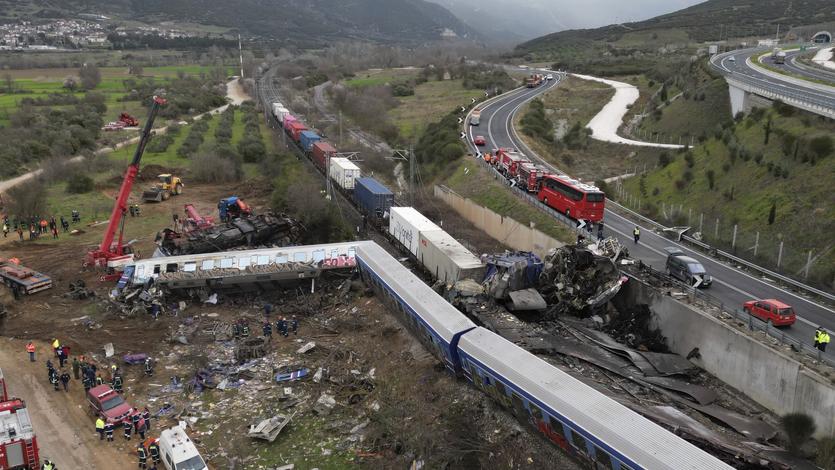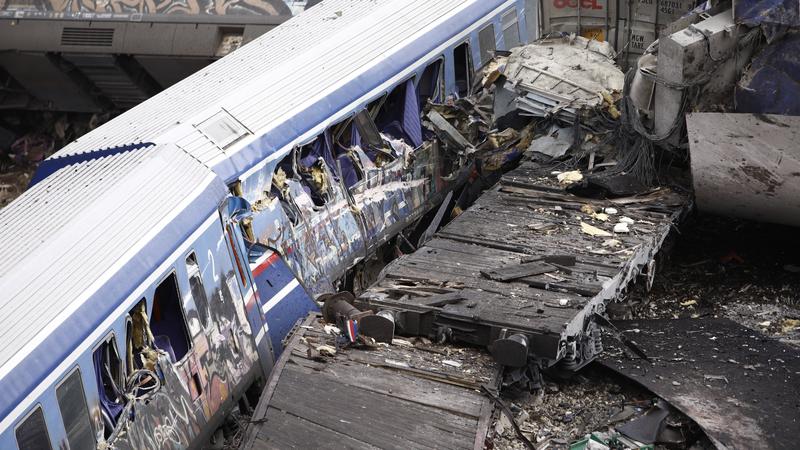 A crane, firefighters and rescuers operate after a collision in Tempe near Larissa city, Greece, March 1, 2023. (PHOTO / AP)
A crane, firefighters and rescuers operate after a collision in Tempe near Larissa city, Greece, March 1, 2023. (PHOTO / AP)
Larissa — Rescuers resumed a search for victims of Greece's deadliest train crash on Thursday, combing through the buckled and crushed remains of carriages that derailed and then caught fire in a disaster that killed at least 42 people.
The high-speed passenger train with more than 350 people on board crashed head-on with a freight train near the city of Larissa late on Tuesday, and temperatures in one carriage had risen to 1,300 Celsius (2,370 F) after it caught fire.
In later statements he said he had accepted the resignations of senior officials in rail operator OSE and its subsidiary ERGOSE. In Athens, around 1,000 people protested outside the offices of Hellenic Train, another branch of the rail network, where some hurled stones at windows
"The most difficult moment is this one, where instead of saving lives we have to recover bodies," 40-year old rescuer Konstantinos Imanimidis told Reuters on the site of the crash.
"Temperatures of 1,200 degrees and more in the carriages cannot allow for anyone to remain alive."
Many of the passengers had to kick through windows to escape the flames. To identify some of the victims, relatives had to give DNA samples at a hospital in Larissa.
READ MORE: Two trains collide in Greece, at least 36 killed, dozens injured
Many of the victims were university students returning home after a long holiday weekend, and officials said the death toll was expected to rise further. Scores were injured.
"It's a difficult operation ... we need to move meticulously, inch by inch, to reach and deliver all the people to their relatives," fire brigade spokesperson Giannis Artopios told state broadcaster ERT.
Investigation
As Greece sought to process a tragedy that its prime minister blamed on human error, railway workers nationwide walked off the job on Thursday, bringing trains across the country to a standstill, saying successive governments had ignored repeated demands to improve safety standards.
The station master of Larissa train station was arrested on Wednesday as authorities probed the circumstances that led to the passenger train, en route to the northern city of Thessaloniki, colliding with another train carrying shipping containers coming in the opposite direction on the same track.
He was expected to appear before a local magistrate on Thursday.
In a televised address on Wednesday night, Prime Minister Kyriakos Mitsotakis who had earlier visited the site of the crash, said that evidence pointed to a human error.
Transport Minister Kostas Karamanlis had earlier resigned saying he was taking responsibility for the state's long standing failures to fix a railway system he said "was not fit for the 21st century."
 Debris of trains lie on the rail lines after a collision in Tempe, about 376 kilometers (235 miles) north of Athens, near Larissa city, Greece, Mar 1, 2023. (PHOTO / AP)
Debris of trains lie on the rail lines after a collision in Tempe, about 376 kilometers (235 miles) north of Athens, near Larissa city, Greece, Mar 1, 2023. (PHOTO / AP)
Protesters hurled rocks at the offices of operator Hellenic Train in Athens in the evening, before being dispersed by volleys of tear gas fired by riot police. Protests also broke out in Thessaloniki.
Nikos Tsouridis, a retired train driver trainer, said drivers involved in the crash had died "because there were no safety measures.
"And why were there no safety measures? The station master made a mistake, he acknowledged it, but surely there should be a safety mechanism to fall back on," he said.
READ MORE: Xi condoles with Greek president over deadly train collision
Greece sold railway operator TRAINOSE under its international bailout programme in 2017 to Italy's Ferrovie dello Stato Italiane, expecting hundreds of millions of euros to be invested in rail infrastructure in the coming years.
The Italian operation has responsibility for passenger and freight, and the Greek state-controlled OSE for infrastructure.


